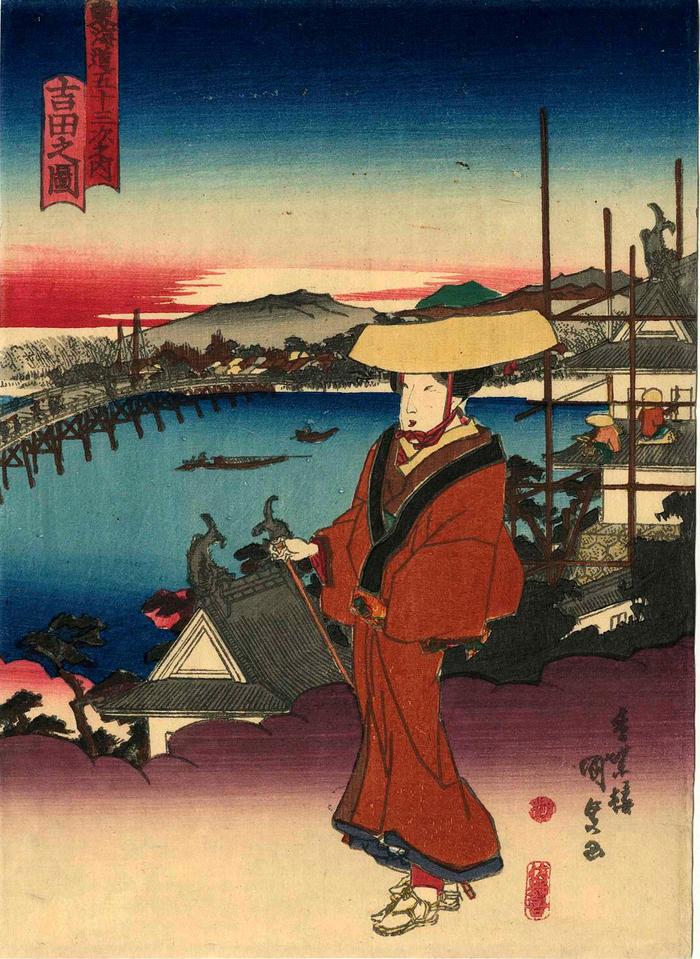Utagawa Kunisada (歌川国貞) / Toyokuni III (三代豊国) (artist 1786 – 01/12/1865)
View of Yoshida (Yoshida no zu: 吉田之図) from the chuban series Fifty-three Stations of the Tōkaidō Road (Tōkaidō gojūsan tsugi no uchi: 東海道五十三次之内)
ca 1838
7 in x 9.75 in (Overall dimensions) Japanese woodblock print
Signed: Kōchōrō Kunisada ga (香蝶楼国貞画)
Publisher: Sanoya Kihei
Censor's seal: kiwame
Museum of Fine Arts, Boston - published by Moriya Jihei
National Diet Library - published by Moriya Jihei and Sanoya Kihei
Spencer Museum of Art - published by Moriya Jihei
British Museum - Hiroshige 'Yoshida Toyokawa-bashi' version
Museum für angewandte Kunst, Vienna
Virginia Museum of Fine Art
Ishikawa Prefectural Museum of Art - they date their copy to 1836
Bryn Mawr
Honolulu Museum of Art - published by Moriya Jihei - dated ca. 1830-35
Google map of Toyohashi, showing the location of Yoshida Castle This print in number 35 in this series. The curatorial files at the Museum für angewandte Kunst in Vienna say: "...Kunisada adheres very closely to Hiroshige's model in the landscape representation, but pulls the two buildings of the castle apart in the foreground in order to place the woman in between."
Kunisada's chuban Bijin Tokaido (東海道美人) series was first published around 1833, after Hiroshige's famous series was underway but not yet complete.
****
Notice the shachi (鯱) rooftop decorations on the buildings, probably a castle, in both the Hiroshige and Kunisada. The shachi is a "mythical carp with the head of a lion and the body of a fish" which is an auspicious symbol of protection and well-being.
****
In Tokaido Landscapes: The Path from Hiroshige to Contemporary Artists, 2011, #35, p. 47, speaking of the original Hiroshige print it says in a text by Sasaki Moritoshi: "A daimyo's procession can be seen faintly on the Yoshida Bridge across the Toyo River. In the foreground is Yoshida Castle. The plasterers at work on he roof are facing different directions so they do not appear to be having a conversation. There is also a tiny figure of a worker, climbing the scaffold and shading his eyes. But the sky and the river are so expansive, if he were to shout, his voice would be swallowed by the void." The Kunisada print has eliminated the worker climbing the scaffolding.
****
In Hiroshige: l'art du voyage, Paris, 2012, p. 80 it says that the mountain in the distance is Honsakagoe with a summit of about 1,247'. The plasterers on the building were probably inspired by Hokusai's workmen on the roof of the Mitsui Shop at Surugachō in Edo from the series 'Thirty-six Views of Mt. Fuji' from ca. 1830-31.
****
Muneshige Narazaki in Masterworks of Ukiyo-e: Hiroshige, the 53 Stations of the Tōkaidō (p. 65) noted: "By contrast, Yoshida was a gay and bustling town, full of girls ready to entertain travelers in upstairs rooms. The scaffolding for workmen on the castle, right, is typically Japanese. The Toyokawa River is one of the few that never dries, even in winter, while in the far distance rises Mount Hōraijizan, a holy place for pilgrims. Yoshida is now part of the city of Toyohashi, a silk-producing center with a population of a quarter of a million." This was in 1969.
****
In Tōkaidō Texts and Tales: Tōkaidō gojūsan tsui by Kuniyoshi, Hiroshige, and Kunisada, edited by Andreas Marks, University Press of Florida, 2015, on page 113 it notes that "Yoshida, present-day Toyohashi, was famous for its brothels. Although the Tokugawa government outlawed prostitution outside of officially sanctioned pleasure quarters in the major cities in 1660, commoner inns were eventually allowed to employ two prostitutes per inn. Such women were called "meal-serving women" (meshimori onna), as they performed double duty in also serving food and drink. In reality the number of women employed as meshimori onna were greater than the officially sanctioned number, and the post town of Yoshida seems to have been famous for solicitations from the second floor..."
****
Illustrated in a small color reproduction in Kunisada's Tokaido: Riddles in Japanese Woodblock Prints by Andreas Marks, Hotei Publishing, 2013, page 71, T24-35.
Sanoya Kihei (佐野屋喜兵衛) (publisher)
landscape prints (fūkeiga 風景画) (genre)
